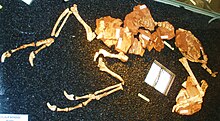Balaur bondoc
|
Balaur bondoc Temporal range: Late Cretaceous, 70 Ma |
|
|---|---|
 |
|
| Holotype specimen | |
| Scientific classification | |
| Kingdom: | Animalia |
| Phylum: | Chordata |
| Class: | Reptilia |
| Clade: | Dinosauria |
| Order: | Saurischia |
| Suborder: | Theropoda |
| Clade: | Avialae |
| Genus: |
†Balaur Csiki et al., 2010 |
| Species: | †B. bondoc |
| Binomial name | |
|
Balaur bondoc Csiki et al., 2010 |
|
Balaur bondoc is a species of theropod dinosaur which lived in what is now Romania during the late Cretaceous period. It is the type species of the monotypic genus Balaur which was described by scientists in August 2010, and was named after the balaur (Romanian pronunciation: [baˈla.ur]), a dragon of Romanian folklore. The specific name bondoc means "stocky", so Balaur bondoc means "stocky dragon" in Romanian. This name refers to the greater musculature that Balaur had compared to its relatives. The genus is known from two partial skeletons including the type specimen.
Seventy million years ago, world sea levels were higher, and the location where its fossils are found was a part of the European Archipelago called Hațeg Island which is also referred to as the "Island of the Dwarf Dinosaurs". Unlike other early members of the group Paraves, which includes Velociraptor, Troodon, and Archaeopteryx, this theropod had not just one but two large, retractable, sickle-shaped claws on each foot, and its limbs were proportionally shorter and heavier than those of its relatives. As with other dinosaurs from Hațeg, such as Magyarosaurus, a dwarf sauropod, its strange features have been argued to show the effects of its island habitat on its evolution.
Balaur is a genus of theropod dinosaurs estimated to have lived about 70 million years ago in the late Cretaceous (Maastrichtian), and contains the single species B. bondoc. The bones of this species were shorter and heavier than those of other basal paravians. While the feet of most early paravians bore a single, large "sickle claw" on the second toe which was held retracted off the ground, Balaur had large retractable sickle claws on both the first and second toes of each foot. In addition to its strange feet, the type specimen of Balaur is unique for its status of being the most complete theropod fossil from the late Cretaceous of Europe. It also possesses a great number of additional autapomorphies, including a reduced and presumably nonfunctional third finger, consisting of only one rudimentary phalanx.
...
Wikipedia
